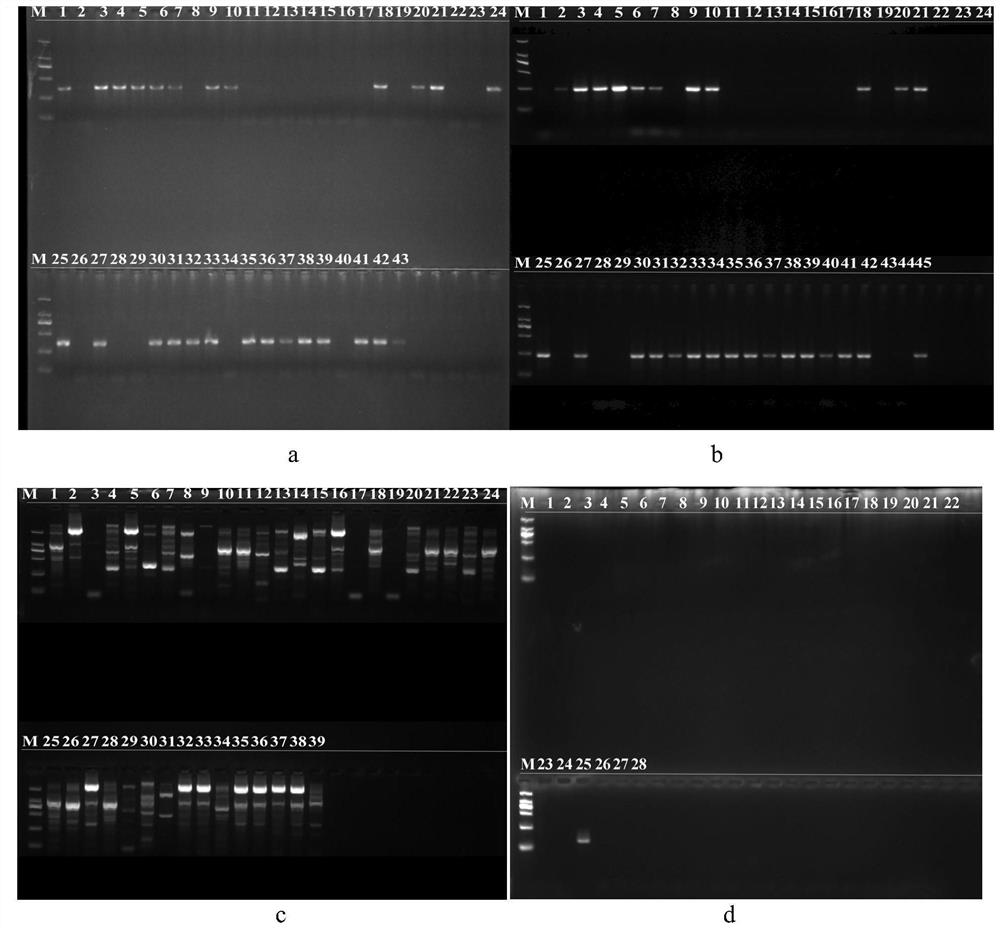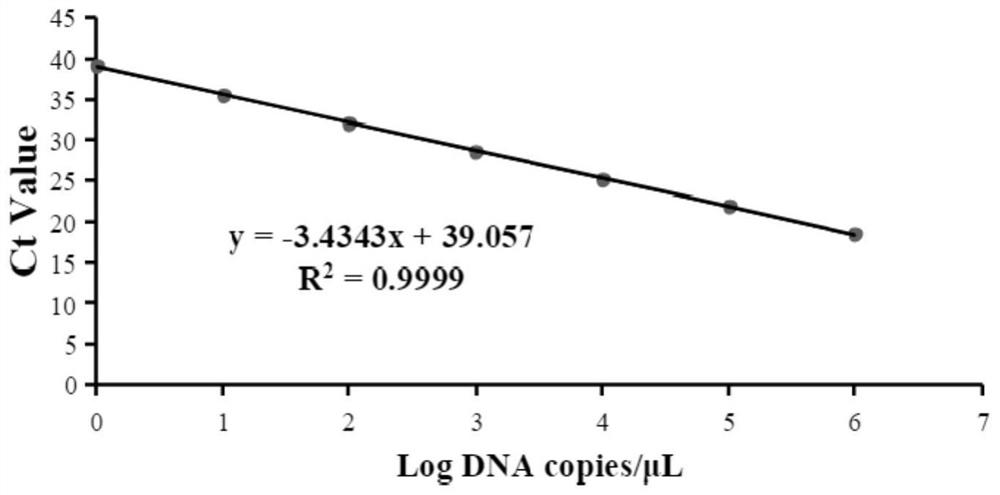Primer and probe for detecting fusarium oxysporum f.sp cucumerinum and application of primer and probe
A technology of cucumber specialization type and Fusarium oxysporum, applied in the agricultural field, can solve the problems of poor accuracy, unable to identify special type, unable to quantitatively analyze pathogenic bacteria, etc., and achieve the effect of good linear relationship
- Summary
- Abstract
- Description
- Claims
- Application Information
AI Technical Summary
Problems solved by technology
Method used
Image
Examples
Embodiment 1
[0031] Embodiment 1 design specific primer, probe
[0032] The present invention selects a conservative sequence in the HPEG (hypothetical protein-encoding gene) sequence in the genome of Fusarium oxysporum cucumber-specific type through bioinformatics analysis, and its nucleotide sequence is shown in SEQ ID NO.4:
[0033]CCAACAAACAGAGCAAAACTAATAGCACGTAGAACCGCCGTCCTTGGCAGTAATCTTGGGCTTCGTAGTATCGATAGCGCCATTGACAACTGGGTAATATCCACCCTTAGCTAGATCCTTGCAGTTGTTGTACCATC
[0034] The present invention designs specific primers and probes for this sequence:
[0035] FOC 3F: 5'-GATGGTACAACAACTGCAAGGA-3';
[0036] FOC 3R: 5'-CCAACAAACAGAGCAAAACTAA-3';
[0037] FOC probe3: FAM5'-AGCACGTAGAACCGCCGTCCTT-3'HBQ1.
[0038] At the same time, the software provides three pairs of primers for the above sequence design, the names and sequences are as follows:
[0039] Primer name Sequence (5'-3') Foc F1 TCACTTGACTTCACTTCACTTCAC Foc R1 GATCTCTGGCCATAACGG Foc F2 CCGTTATG...
Embodiment 2
[0042] Embodiment 2 examines the specificity of primer
[0043] FOC 3F and FOC 3R were used as primers, FOC probe3 was used as a probe, and 27 different pathogen DNAs were used as templates for qPCR amplification. 27 different pathogens including Fusarium oxysporum wilt specific; Fusarium oxysporum specific watermelon; Fusarium oxysporum specific melon; ;Fusarium oxysporum capsicum specialization type; Fusarium oxysporum specialization type sunflower; Fusarium graminearum; Fusarium pseudograminea; Rhizoctonia solani; Fusarium laminarum; Fusarium equisetum; Fusarium glucosporum; Black spot fungus; Verticillium black and white; Botrytis cinerea.
[0044] The PCR amplification system is a 25 μL system, and the system is as follows: rTaq enzyme 0.5 μL, Mg 2+ 3 μL, 2.5 μL of 10×Buffer, 2.0 μL of dNTP, 1.0 μL of each specific primer and probe, 5 μL of DNA template, 5 μL of BSA, ddH 2 O 4 μL.
[0045] The qPCR amplification conditions were pre-denaturation at 95°C for 1 min; den...
Embodiment 3
[0050] Embodiment 3 builds standard curve
[0051] Using the cucumber-specific genome of Fusarium oxysporum as a template, amplified with the primers obtained from the above screening, the amplified product was purified and cloned into the vector pMD18-T, and transformed into Escherichia coli DH5α by heat shock transformation. reproduce in cells. Colonies containing recombinant plasmids were screened on LB culture dishes with ampicillin antibiotics and verified by PCR to obtain recombinant plasmids containing specific sequences.
[0052] A plasmid extraction kit was used to extract the recombinant plasmid, and the extracted recombinant plasmid was digested with the endonuclease EcoRI. The digested product was subjected to agarose gel electrophoresis and then gel-cut to recover the corresponding fragments. The fragments were recovered using the Promega Gel Extaction Kit. The Mofei Nanodrop 2000 spectrophotometer measures the DNA concentration of the recombinant plasmid, and ca...
PUM
 Login to View More
Login to View More Abstract
Description
Claims
Application Information
 Login to View More
Login to View More - R&D Engineer
- R&D Manager
- IP Professional
- Industry Leading Data Capabilities
- Powerful AI technology
- Patent DNA Extraction
Browse by: Latest US Patents, China's latest patents, Technical Efficacy Thesaurus, Application Domain, Technology Topic, Popular Technical Reports.
© 2024 PatSnap. All rights reserved.Legal|Privacy policy|Modern Slavery Act Transparency Statement|Sitemap|About US| Contact US: help@patsnap.com










